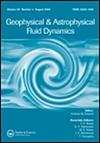河流羽流的不稳定性和垂直混合:在比斯开湾的应用
IF 1.1
4区 地球科学
Q3 ASTRONOMY & ASTROPHYSICS
Geophysical and Astrophysical Fluid Dynamics
Pub Date : 2020-09-02
DOI:10.1080/03091929.2020.1814275
引用次数: 8
摘要
在比斯开湾(东北大西洋),长期存在的涡旋及其引起的锋面活动对中尺度和亚中尺度动力学有很大贡献。潮汐和河流羽流也有助于锋面活动。生物生产力对河流羽流锋面和外部强迫(潮汐和风)很敏感。考虑到河流羽流的重要性,本文研究了河流羽流的结构、稳定性和垂直混合过程(类似于吉伦特河产生的羽流)。在评估搅拌(锋生/锋溶)或垂直混合(这里从Ertel位涡混合参数化)过程时,考虑了再气化预算。利用高分辨率的理想数值模拟,我们分析了凸起和羽流海岸部分的演变,并对河流流量、西南风和M2潮汐进行了敏感性实验。由于正压/斜压混合不稳定性,在中等(高)流量的情况下,凸起和海岸流是稳定的(不稳定的)。在不稳定情况下,近地表对称不稳定和垂直剪切不稳定发生在沿岸流和罗斯比数较大的凸起核心。当西南风吹起时,河流羽流被埃克曼运输挤压到海岸附近。在河口以北的海岸部分(远场),河流羽流受到锋面对称、斜压、正压和垂直剪切不稳定的影响。相反,当M2潮存在时,河羽在近场呈现正压性、正压性和对称不稳定性。内部垂直混合是由平流(搅拌)和锋生过程引起的。锋生在远场(西南风存在时)或近场(M2潮活跃时)占优势。锋面生作用在远场地区的非强迫河流羽流(中高流量的河流羽流)中很重要。当西南风吹来时,位涡在远场受到侵蚀。这主要是由于在表面占主导地位的摩擦过程。这项研究已经确定了在不同情况下影响河流羽流的不稳定性,以及改变分层的局部湍流过程。本文章由计算机程序翻译,如有差异,请以英文原文为准。
Instabilities and vertical mixing in river plumes: application to the Bay of Biscay
In the Bay of Biscay (north-east Atlantic), long-living eddies and the frontal activity that they induce substantially contribute to mesoscale and submesoscale dynamics. Tides and river plumes also contribute to frontal activity. Biological productivity is sensitive to river plume fronts and to external forcings (tides and wind). Considering the importance of river plumes, we study here the structure, stability and vertical mixing processes in such river plumes (similar to those generated by the Gironde river). Restratification budget is considered here for evaluating stirring (frontogenetic/frontolytic) or vertical mixing (parametrised here from Ertel potential vorticity mixing) processes. Using high-resolution idealised numerical simulations, we analyse the evolution of the bulge and of the coastal part of this plume and we conduct sensitivity experiments to the river discharge, to southwesterly winds and to M2 tides. The bulge and the coastal current are stable (unstable) in case of moderate (high) river discharge, due to mixed barotropic/baroclinic instabilities. In the unstable case, near surface symmetric and vertical shear instabilities develop in the coastal current and in the core of the bulge where the Rossby number is large. When southwesterly winds blow, the river plume is squeezed near the coast by Ekman transport. The river plume is then subject to frontal symmetric, baroclinic, barotropic and vertical shear instabilities in the coastal part, north of the estuary (its far field). Conversely, in the presence of M2 tides, the river plume is barotropically, baroclinically and symmetrically unstable in its near field. Interior vertical mixing is induced by advective (stirring) and frontogenetic processes. Frontogenesis is dominant in the far-field (in the presence of southwesterlies) or in the near-field (when M2 tide is active). Frontogenesis is important in the far-field region in unforced river plumes (both with moderate and high river discharges). Potential vorticity is eroded in the far-field when southwesterlies blow. This is primarily due to the frictional processes which are dominant at the surface. This study has identified the instabilities which affect a river plume in different cases, and the local turbulent processes which alter the stratification.
求助全文
通过发布文献求助,成功后即可免费获取论文全文。
去求助
来源期刊

Geophysical and Astrophysical Fluid Dynamics
地学天文-地球化学与地球物理
CiteScore
3.10
自引率
0.00%
发文量
14
审稿时长
>12 weeks
期刊介绍:
Geophysical and Astrophysical Fluid Dynamics exists for the publication of original research papers and short communications, occasional survey articles and conference reports on the fluid mechanics of the earth and planets, including oceans, atmospheres and interiors, and the fluid mechanics of the sun, stars and other astrophysical objects.
In addition, their magnetohydrodynamic behaviours are investigated. Experimental, theoretical and numerical studies of rotating, stratified and convecting fluids of general interest to geophysicists and astrophysicists appear. Properly interpreted observational results are also published.
 求助内容:
求助内容: 应助结果提醒方式:
应助结果提醒方式:


